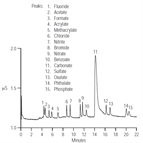Find methods for your needs
Refine by Feature
Displaying 1-3 of 3 results for Tag: Acrylate
AU157: Using a Reagent-Free Ion Chromatography System to Monitor Trace Anion Contamination in the Extracts of Electronic Components
Instrument Type: ICDionex Application Note 153 (AN153) showed that ion chromatography (IC) successfully determines low μg/L and, for some analytes, high ng/L anions in extracts of electronic components. The IC method in AN153 separated 14 inorganic anions and organic acids on an IonPac AS17 column set after sample preconcentration. In this application update a hydroxide gradient program similar to, but faster than, the program used in AN153 separates a new set of 14 anions.
AN153: Monitoring for Trace Anion Contamination in the Extracts of Electronic Components.
Instrument Type: ICThis application note focuses on the determination of ionic contamination of disk drive components. A comprehensive anion analysis of drive components prior to manufacturing can significantly reduce the incidence of corrosion and head-to-disk interface failures. The anions most routinely monitored are fluoride, chloride, bromide, nitrate, sulfate, and phosphate. High-volume direct injection and preconcentration are the two methods used to increase IC sensitivity. This note describes the use of these approaches to determine trace anion contaminants in extracts of disk drive components.
AN146: Determination of Trace Anions in High-Purity Waters by Ion Chromatography Using High Volume Direct Injection.
Instrument Type: ICThis application note describes an ion chromatographic method using the microbore IonPac AS17 column to determine trace concentrations of common inorganic anions, low-molecular-weight organic acids, as well as acrylate, methacrylate, benzoate, and phthalate. These contaminants can come from some of the following sources: cleaning agents, adhesives, oils, and solder fluxes. Anionic contamination is known to cause corrosion in microelectronic circuitry. The analytes are detected by suppressed conductivity with a 2-mm ASRS ULTRA operated in the “Gas-Assisted Recycle” mode.



